OXER1, a G protein-coupled oxoeicosatetraenoid receptor, mediates the survival-promoting effects of arachidonate 5-lipoxygenase in prostate cancer cells
- PMID: 23643940
- PMCID: PMC3892773
- DOI: 10.1016/j.canlet.2013.04.027
OXER1, a G protein-coupled oxoeicosatetraenoid receptor, mediates the survival-promoting effects of arachidonate 5-lipoxygenase in prostate cancer cells
Abstract
Inhibition of 5-Lox induces apoptosis in prostate cancer cells by inactivating PKCε which is prevented by 5-oxoETE, and activators of PKCε prevent 5-Lox inhibition-induced apoptosis, suggesting that 5-Lox metabolites exert survival signaling via PKCε. However, mechanisms by which 5-Lox metabolites activate PKCε are not understood yet. We found that prostate cancer cells express high levels of OXER1, a G protein-coupled 5-oxoETE receptor, which delivers signal by generating diacyl-glycerol through phospholipase C-beta. Interestingly, we found that U73122, an inhibitor of PLC-beta, interrupts the apoptosis-preventing effect of 5-oxoETE, and exogenous diacyl-glycerol effectively prevents 5-Lox inhibition-induced apoptosis, suggesting that 5-oxoETE signals via OXER1 to promote prostate cancer cell survival.
Copyright © 2013 Elsevier Ireland Ltd. All rights reserved.
Conflict of interest statement
Figures
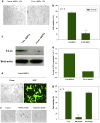
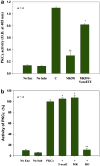
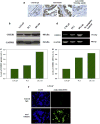


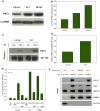
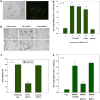

Similar articles
-
Inhibition of 5-lipoxygenase triggers apoptosis in prostate cancer cells via down-regulation of protein kinase C-epsilon.Biochim Biophys Acta. 2011 Dec;1813(12):2108-17. doi: 10.1016/j.bbamcr.2011.07.015. Epub 2011 Jul 30. Biochim Biophys Acta. 2011. PMID: 21824498 Free PMC article.
-
Expression of 5-oxoETE receptor in prostate cancer cells: critical role in survival.Biochem Biophys Res Commun. 2006 Jan 6;339(1):93-8. doi: 10.1016/j.bbrc.2005.10.189. Epub 2005 Nov 8. Biochem Biophys Res Commun. 2006. PMID: 16289380
-
Wedelolactone, a medicinal plant-derived coumestan, induces caspase-dependent apoptosis in prostate cancer cells via downregulation of PKCε without inhibiting Akt.Int J Oncol. 2012 Dec;41(6):2191-9. doi: 10.3892/ijo.2012.1664. Epub 2012 Oct 16. Int J Oncol. 2012. PMID: 23076676 Free PMC article.
-
5-lipoxygenase antagonist therapy: a new approach towards targeted cancer chemotherapy.Acta Biochim Biophys Sin (Shanghai). 2013 Sep;45(9):709-19. doi: 10.1093/abbs/gmt064. Epub 2013 Jun 9. Acta Biochim Biophys Sin (Shanghai). 2013. PMID: 23752617 Review.
-
Membrane Androgen Receptors Unrelated to Nuclear Steroid Receptors.Endocrinology. 2019 Apr 1;160(4):772-781. doi: 10.1210/en.2018-00987. Endocrinology. 2019. PMID: 30753403 Review.
Cited by
-
Inhibition of 5-oxo-6,8,11,14-eicosatetraenoic acid-induced activation of neutrophils and eosinophils by novel indole OXE receptor antagonists.J Med Chem. 2014 Jan 23;57(2):364-77. doi: 10.1021/jm401292m. Epub 2014 Jan 6. J Med Chem. 2014. PMID: 24351031 Free PMC article.
-
Targeted Radionuclide Therapy of Prostate Cancer-From Basic Research to Clinical Perspectives.Molecules. 2020 Apr 10;25(7):1743. doi: 10.3390/molecules25071743. Molecules. 2020. PMID: 32290196 Free PMC article. Review.
-
Antagonizing effects of membrane-acting androgens on the eicosanoid receptor OXER1 in prostate cancer.Sci Rep. 2017 Mar 14;7:44418. doi: 10.1038/srep44418. Sci Rep. 2017. PMID: 28290516 Free PMC article.
-
Targeting the OXE receptor as a potential novel therapy for asthma.Biochem Pharmacol. 2020 Sep;179:113930. doi: 10.1016/j.bcp.2020.113930. Epub 2020 Mar 30. Biochem Pharmacol. 2020. PMID: 32240653 Free PMC article. Review.
-
Molecular Characterization of Membrane Steroid Receptors in Hormone-Sensitive Cancers.Cells. 2021 Nov 3;10(11):2999. doi: 10.3390/cells10112999. Cells. 2021. PMID: 34831222 Free PMC article. Review.
References
-
- Jemal A, Siegel R, Xu J, Ward E. Cancer statistics, 2010. CA Cancer J Clin. 2010;60:277–300. - PubMed
-
- Fleshner N, Bagnell PS, Klotz L, Venkateswaran V. Dietary fat and prostate cancer. J Urol. 2004;171:19–24. - PubMed
-
- Kolonel LN, Nomura AN, Cooney RV. Dietary fat and prostate cancer: current status. J Natl Cancer Inst. 1999;91:414–428. - PubMed
-
- Wang Y, Corr JG, Thaler HT, Tao Y, Fair WR, Heston WD. Decreased growth of established prostate LNCaP tumors in nude mice fed a low-fat diet. J Natl Cancer Inst. 1995;87:1456–1462. - PubMed
-
- West DW, Slattery ML, Robison LM, French TK, Mahoney AW. Adult dietary intake and prostate cancer risk in Utah: a case control study with special emphasis on aggressive tumors. Cancer Causes Control. 1991;2:85–94. - PubMed
Publication types
MeSH terms
Substances
Grants and funding
LinkOut - more resources
Full Text Sources
Other Literature Sources
Medical
Molecular Biology Databases

